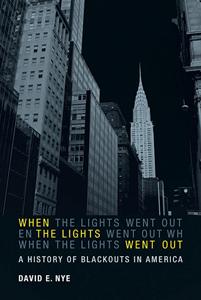Utter Darkness
When the Lights Went Out: A History of Blackouts in America, by David E. Nye ’68 (MIT Press)
Reviewed by Robert E. Weir
 |
[Nonfiction] Joni Mitchell wasn’t singing about electricity when she crooned “You don’t know what you’ve got till it’s gone,” but she could have been. Just ask Amherst College employees commuting to work from Shutesbury, Mass., and beyond during the winter of 2008, when a devastating ice storm left them without power for up to two weeks. David Nye is a history professor at the University of Southern Denmark and didn’t experience that deprivation, but he understands the anguish—he’s literally written the book on power blackouts. His is a fascinating account that’s equal parts history, social psychology, economics and basic science for right-brained readers.
Blackouts. As Nye explains, their very meaning is time-bound. The term would have meant nothing to preindustrial people, and it meant merely the dimming of gas lights for 19th-century city dwellers. In World War II a blackout was a coerced time in the dark in the interest of national security. From 1890 to 1965, an electricity blackout was a local event—sometimes within just a single building, as it was customary for larger structures to have on-site generating facilities. So how did we get to Nov. 9, 1965, when a massive power failure darkened much of the Eastern seaboard? Blame it on the grid, the network that allows electricity generated in faraway places to be transmitted to substations and doled out to millions of customers. The very thing that allows Americans to consume energy in big gulps is also a force with the potential to wreak havoc on a scale unfathomable to earlier generations.
Nye—who was in New York City during the 1965 blackout—recounts how Manhattanites quickly moved from bewilderment to bemusement and “public intimacy” in which normally harried and private urban dwellers engaged in spontaneous candlelight dinners, impromptu carol-singing and random acts of kindness. Nye evokes social theorist Victor Turner’s theory of liminal time—transitional moments in which the extraordinary is possible—to explain how New York “flipped its fuse and became ‘Fun City.’”
“Fun City” New York raises the question of why a 1977 blackout touched off a destructive wave of looting, arson and social mayhem. Simplistic explanations blamed this on the loosening of norms and respect for authority, but Nye argues that blackouts in 1977 and 2003 induced crisis not because of social attitudes but because of changed American consumption patterns. The gist of Nye’s book is that we now live in a world defined by electricity and electromagnetic waves. We are so thoroughly hooked that our bad habits are the new norm. Want a doomsday scenario? Consider that an upper-atmosphere electromagnetic impulse would literally bring America to a halt—Americans would be unable to communicate, compute, cook or commute.
Nye argues that those looking for villains—Enron comes in for a thorough thrashing—should look to the supply side of the economic ledger. Deregulation in the 1980s, he argues, unleashed those who denied that the energy crisis was real.
Still, Nye is no Cassandra. Americans worry about terrorist attacks, but Nye tells us that we have an ally in an antiquated and poorly integrated grid. It would be hard for terrorists to blackout the nation. There is, metaphorically speaking, no master switch to turn off.
Nye’s biggest hope is that blackouts will give way to “greenouts”; that is, that we will accelerate the move to efficiency, tapping into alternative energy sources and developing new technology. This will require Americans to come to grips with our addiction, break with our all-consuming ways and embrace a world of limits.
Weir is a visiting lecturer in the history department at UMass.